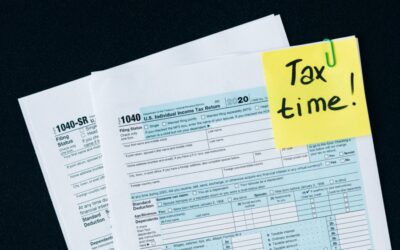
Updated March 16th, 2023
You’ve probably heard a lot about the transition to green energy sources lately. Included in that upheaval is driving electric vehicles instead of gas powered cars and trucks. To incentivize this change and accelerate its progress, the government has created the electric vehicle tax credit. Here you will learn how to claim your Electric Vehicle Tax Credit.
Key Takeaways: How to Claim the Electric Vehicle Tax Credit
- The electric vehicle tax credit is a non-refundable credit aimed at incentivizing the purchase of electric vehicles to promote green energy and reduce emissions.
- The EV tax credit ranges from $2,500 to $7,500, depending on the vehicle type and model. However, the credit starts to phase out once an automaker sells over 200,000 qualifying vehicles.
- To claim the EV tax credit, you need to purchase a qualifying electric vehicle, obtain a letter of certification from the dealership, fill out IRS Form 8936, and look for state rebates and credits.
- Tesla vehicles no longer qualify for the tax credit as the company has surpassed the 200,000 sales benchmark.
- In addition to the federal tax credit, some states offer rebates and incentives for electric vehicle purchases, although these vary by state and are subject to change.
- The electric vehicle tax credit is just one of the ways the government encourages environmentally friendly behavior and the adoption of green energy initiatives.
How to Claim the Electric Vehicle Tax Credit
- Purchase a Qualified Electric Vehicle
- Get a Letter of Certification from Dealership
- Fill Out IRS Form 8936
- Look for State Rebates and Credits
There are two types of tax credits: refundable tax credits and non-refundable tax credits. Both types of tax credits will lower the amount of taxes you owe. However, they become different if the tax credit amount lowers your taxes to zero with a credit left over.
A non-refundable tax credit, as its name implies, will not see the remainder of the credit applied toward your bank account. However, a refundable tax credit will indeed deposit the remainder of the credit (once it zeros out your tax burden) into your checking account.
The electric vehicle tax credit (EV tax credit) is non-refundable. However, that doesn’t mean it isn’t worth filling out the paperwork. Far from it—especially if you need to reduce a tax burden. Paying less taxes is certainly better than paying more, right?
As a side note, we should also mention tax deductions. Deductions are items that lower your taxable income, not your tax burden. This includes mileage rate deductions. Speak with an accountant to determine what other deductions you can claim for the vehicle. If you are self-employed and use it in the course of conducting business, don’t overlook the deduction.
Schedule a consultation with one of Anderson Advisor’s business tax experts today to determine whether it’s possible to rent your personal residence to your business in an effort to lower your tax burden!
Tax & Asset Protection Workshop
Learn about Real Estate & Asset Protection at our next
FREE LIVE STREAM
What is the Electric Vehicle Tax Credit?
Tax credits for electric vehicles started in 2008, with EV credits still available today for taxpayers who purchase a qualifying vehicle.
Like most tax credits and certain types of deductions, these tax incentives are meant to encourage certain forms of behavior—like buying an electric car. There’s a lot of debate around just how environmentally friendly an electric vehicle is once it rolls off the production line. Regardless of this debate, if you purchase an EV, you can claim a generous tax credit.
How Much is the Electric Vehicle Tax Credit?
The EV tax credit starts at $2,500 and goes up to $7,500, but the exact amount depends on the nature of the vehicle itself.
Hybrid models, such as the Toyota Prius Prime Plug-in, only qualify for a credit of approximately $4,500. However, there are many vehicles made by Audi, BMW, Ford, GM, Hyundai, Kia, Mazda, Nissan, Porsche, Volkswagen, and Volvo that qualify for the full $7,500 credit.
Take note that the EV credit is designed to start phasing out after an automaker has sold 200,000 EVs. The credit is then cut down to a maximum of $3,750 for the next two calendar quarters after the company has passed this benchmark. Then it continues to halve every two quarters until it zeros out one year after the 200K+ sales milestone was passed.
How to Claim the Electric Vehicle Tax Credit
Thinking about purchasing a new electric vehicle? It’s a good idea to familiarize yourself with the process for claiming the electric vehicle tax credit.
1. Purchase a Qualified Electric Vehicle
As mentioned, pretty much every major car manufacturer is selling electric vehicles these days. In the future we may see all-electric fleets, and many believe this might not be too far away. This means you can go to a dealership affiliated with any of the brands mentioned above, plus others like Chrysler or Honda, and ask which models are electric. The dealer will know which models qualify for the tax credit. They will also know which ones qualify for the full credit. You can also do your own research online.
Take note that if you are thinking of buying a Tesla, you will not be able to claim the tax credit. Tesla is no longer a qualified vehicle because it has long surpassed the 200,000 models sold benchmark.
A few other qualifications that need to be mentioned. The vehicle must have four wheels, it can’t weigh more than 14,000 pounds, it must be charged by connecting it to an external power source with a plug. Its battery also must last four kilowatt hours. The car must be made after 2010, and the credit cannot be claimed on used vehicles. In most cases, you must also own the vehicle, not lease it, but this is not universally true.
The debate for leasing versus owning a vehicle will have other tax implications as well. You can learn more about which situation may be right for you by attending our Tax Tuesday Webinar and asking one of our tax planning experts.
2. Get a Letter of Certification from Dealership
When you purchase the electric vehicle, you will want to obtain a letter of certification from the dealer so that it can be forwarded to the IRS when you claim the credit on your personal tax return.
The letter should specify the vehicle’s make, model and the tax year that it qualifies for the EV tax credit.
The letter of certification proves that the vehicle you have purchased meets the requirements to claim the federal incentives. This means that it must be a qualifying vehicle that meets the electric vehicle sales threshold set by the IRS.
3. Fill Out IRS Form 8936
IRS Form 8936 is specifically dedicated to claiming the tax credit for an electric vehicle. This form can be downloaded from the IRS website and filled out on a computer before printing.
You will need to submit this form to the IRS when you file your taxes, so keep tax deadlines in mind to make sure you have time to compile all the requisite forms and paperwork.
If you are using software like Turbotax to do your taxes, it’s very likely that they will have these forms built into the software to make claiming this credit easier.
4. Look for State Rebates and Credits
In addition to the electric vehicle federal tax credit, don’t forget to look for state tax credits you qualify for as well. Colorado, Connecticut, Delaware, Maryland, California, Massachusetts, Oregon, and New York all offer tax rebates for purchasing an electric vehicle.
Keep in mind the nature of these rebates varies from state to state, and some of them have already started phasing them out, making the rebate smaller than they were in previous tax years. For example, in California you can get a $2,500 rebate for purchasing or leasing a zero emission EV, but only if your income falls below $150,000 for single filers and $300,000 for couples filing jointly. In New York, you can get a $500 rebate if your EV costs more than $60,000, but $2,000 if it costs less than $60,000 (take this into consideration as you negotiate the price of the vehicle).
Check with your state tax department to see a list of the potential rebates you may qualify for. Some tax rebates do phase out, so check with the dealer you purchase the electric vehicle from, because they will likely have the most up to date information on which vehicles qualify for rebates.
Take Advantage of Electric Vehicle Tax Incentives
In the United States, companies like General Motors, Ford, and Chrysler are adopting the ingenuity of first-generation companies in the battery electric vehicle space, making their own electric vehicle fleets to supplement or at least augment their conventional vehicle offerings. The free market is offering a steady stream of customers, even if a vehicle that needs an EV charging station has not reached universal adoption rates quite yet.
However, the government’s environmental protection and green energy initiatives have led them to offer a federal EV tax credit via the Internal Revenue Service. They’ve done this in order to incentivize consumer participation for purchasing vehicles powered by an electric motor instead of traditional fossil fuels. In addition to the federal income tax credit for an electric vehicle purchase, some states with more accelerated zero-emission programs are offering residential customers EV incentives in the form of a clean vehicle rebate project.
Although the exact nature of these programs varies from state to state and depends on a variety of factors, the general idea of these electric vehicle incentives is to increase the number of EV owners. If you’re in the position to purchase a new vehicle (or just want to save energy and escape rising gas prices), you might give some serious thought to investing in an electric vehicle.
As always, take advantage of our free educational content and every other Tuesday we have Toby’s Tax Tuesday, a great educational series. Our Structure Implementation Series answers your questions about how to structure your business entities to protect you and your assets.
Additional Resources:
- Claim your FREE Strategy Session, and learn how Anderson Advisors can protect your assets.
- Join our next Tax & Asset Protection event to learn more advanced tax minimization & entity structuring strategies
- For all things investing, check out the Infinity Investing YouTube channel
- Subscribe to our YouTube channel to make sure you never miss the latest strategies & updates
Bonus Video
Free Strategy Session with an Anderson Advisor
Receive a detailed risk assessment to assist in lowering problem areas that could wipe out all of your assets with one wrong move. Speak with an Anderson Professional Advisor to get your FREE Strategy Session.
Limited-Time Offer: ($750 value.)















